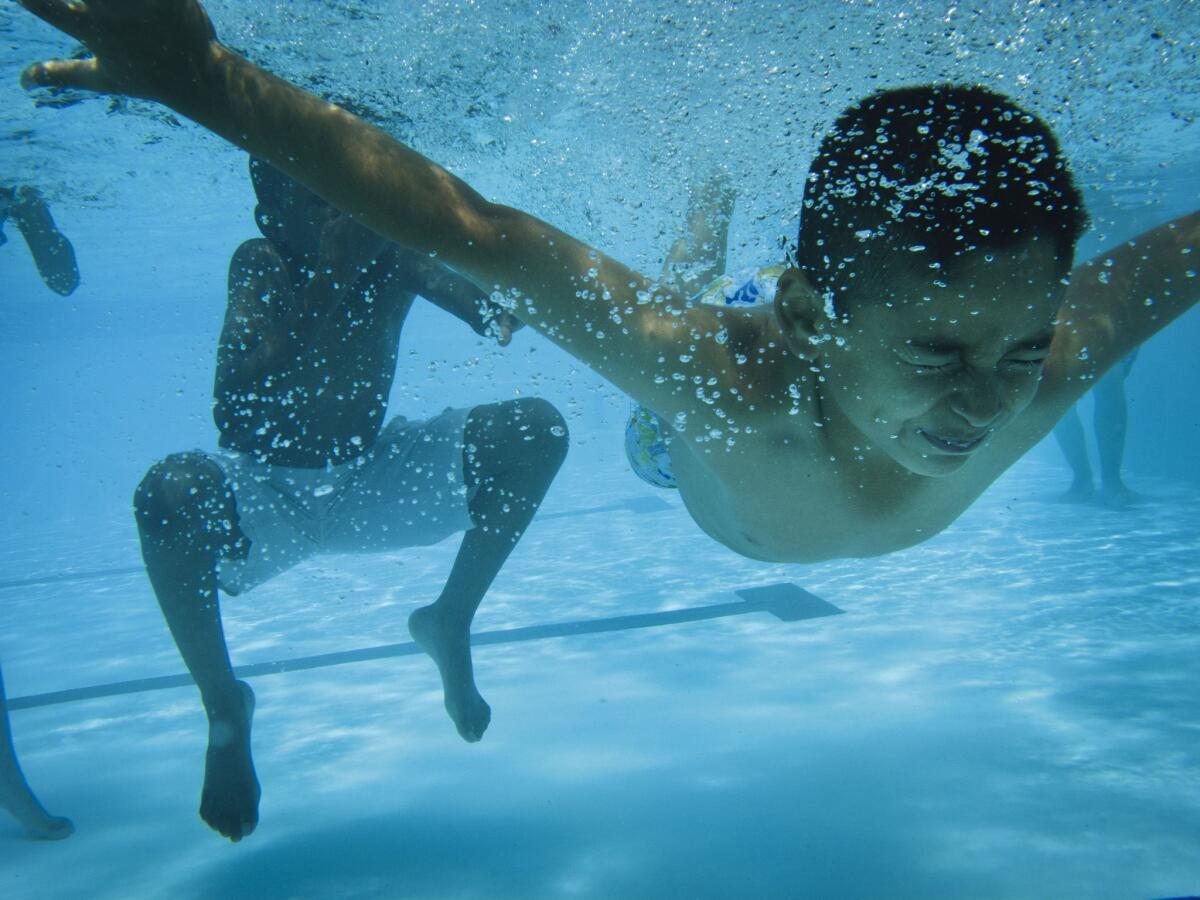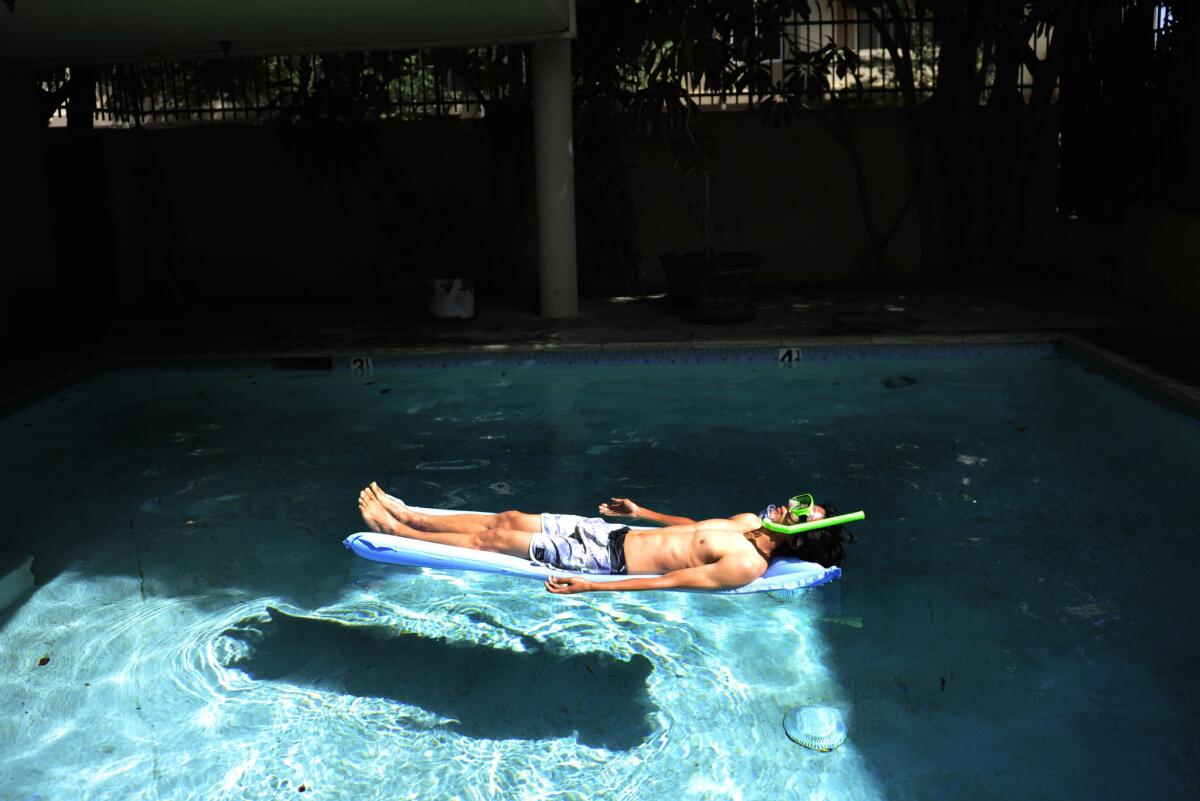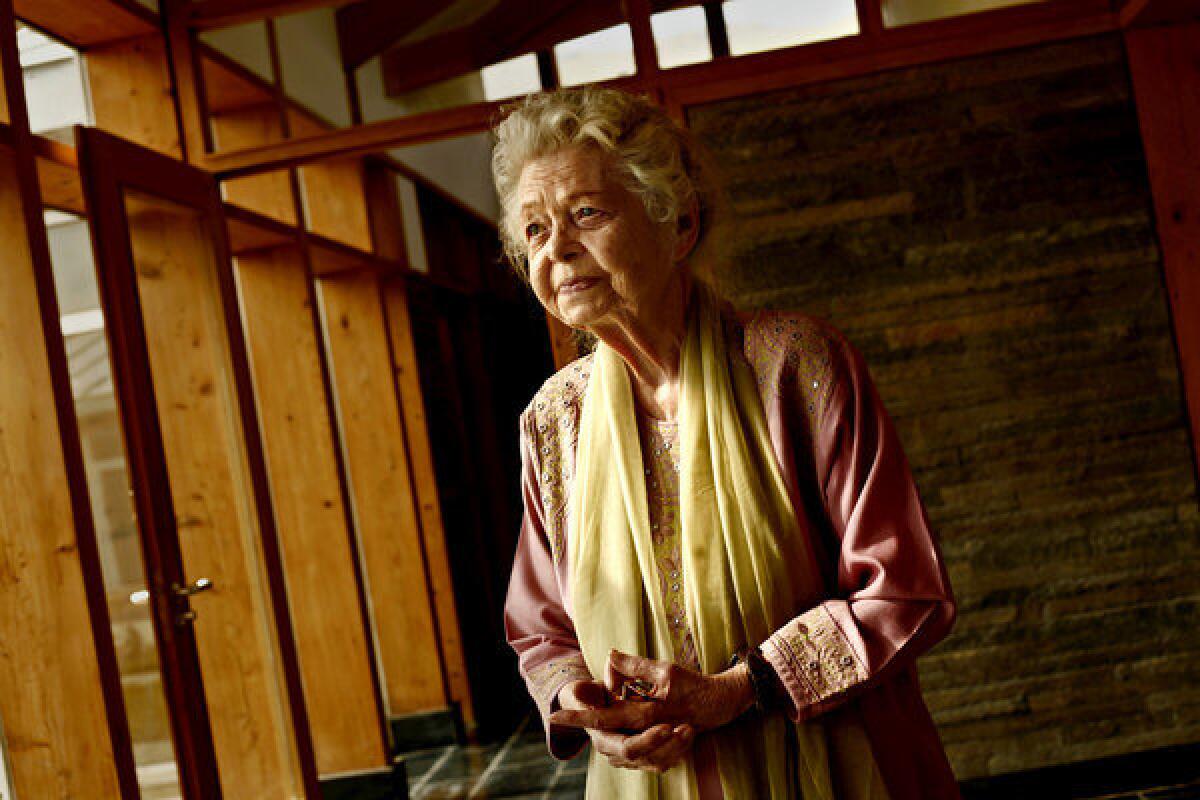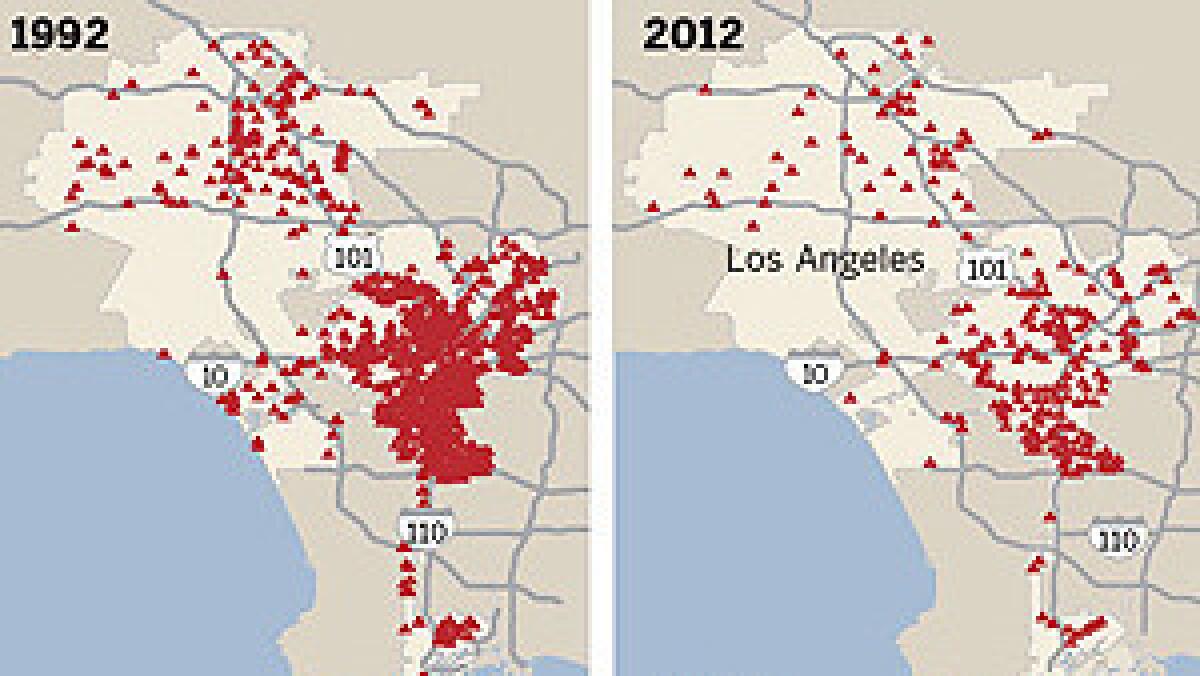Mappers spot all the pools in L.A. Basin
Two academics wondered about the number of swimming pools in the L.A. Basin. They got their answer with computer mapping, but the easy access to the data was unnerving.
- Share via

German graphic designer Benedikt Gross was flying into Los Angeles for the first time when he gazed out the jetliner's window and was mesmerized by the hundreds of shimmering blue swimming pools tiling the landscape below.
The image of all those backyard oases visible only from the sky stuck with him, but he didn't make much of it until a few months later, when he bumped into Joseph Lee at a Massachusetts Institute of Technology research lab that deals with urban dwellers' relationship with technology.
"I wonder how many pools there are," said Gross, 33, who was working at the Senseable City Lab as part of his master's degree studies at London's Royal College of Art.
Lee, a UCLA graduate who was at MIT as a research assistant, responded quickly:
"L.A. is endless from the air. The turquoise pools you see are beautiful."
But they knew the number of pools was finite, and on a whim they decided to find out exactly how many there were.
"We didn't know where we were going," remembers Lee, 23, an aspiring geographer and cartographer from Vallejo. "Things just built themselves the more we dove deeper."
A year later, the result is the "Big Atlas of L.A. Pools," a digital analysis of every swimming pool in the Los Angeles Basin. Using complex computer mapping, they counted 43,123 between the Hollywood Hills and San Pedro, from pools shaded by leaf-covered pergolas in Santa Monica to ones surrounded by chain-link fences in Alhambra.
Along the way, they discovered something more than just the real-world versions of the iconic David Hockney pool utopias. Their project also proved that two non-experts were able to take a massive amount of freely available data to peek into other people's lives.
"At first, the project was mostly just an experiment to see whether or not we could locate and draw all the pools from aerial imagery we acquired," Lee says.
But they became unnerved by the easy access to the data, he says.
"It's creepy to know that encoded in the freely available information are very personal details that you may not want others to know."


Buyers paid millions for "Los Tiempos," a 1913 Beaux Arts mansion. It came with a pool, of course. (Gary Friedman / Los Angeles Times) More photos
The two men started by sending two sets of satellite photos from the federal National Agriculture Imagery Program — one a true color composite, the other a false-color version to make the pools easier to spot — to a crowd-sourcing service in India. They paid workers $300 to draw the outline of every pool shown in the pictures onto a computer program.
They then spent an additional $350 to have the initial count double-checked by Amazon Mechanical Turk, another crowdsourcing service. Workers there inspected images of each swimming pool's location to confirm it was a body of water and not, say, a house with a blue roof.
The duo used eight publicly available databases, including latimes.com's Mapping L.A., for the project. Other data sets used included the county's parcel boundaries service, the Los Angeles County sheriff's crime database, the assessor's data set and a database that contained those donating money during the Proposition 8 campaign on gay marriage and the Megan's Law list of registered child molesters.
That's why the "Big Atlas of L.A. Pools" came to include a map that shows where sex offenders with swimming pools live.
"It seems that very few sex offenders live on property with pools," the analysis concluded.
L.A. is endless from the air. The turquoise pools you see are beautiful."— Joseph Lee, MIT research assistant
Their research, which fills 6,000 pages in 74 printed volumes, concludes that the typical swimming pool in Los Angeles is oval-shaped and measures 16 feet, 4 inches by 33 feet, 6 inches, though there are numerous oddly shaped pools squeezed into backyards.
The atlas found that Beverly Hills has 2,481 — the highest per capita in the region. Long Beach boasts 2,859 pools, Rancho Palos Verdes 2,592. They could not come up with a total for the city of Los Angeles, because their count left out the San Fernando Valley, although the Brentwood section of the city has 1,920.
But two other Los Angeles neighborhoods have no backyard pools at all: Watts and Florence. Of the four public pools in area parks, three were apparently closed for the season and empty when the satellite photo was taken, said Catarah Hampshire, a spokeswoman with the Los Angeles County Department of Parks and Recreation.
When their analysis of the pools was complete, Lee and Gross spent $3,700 to publish the 74 volumes. So far, only one complete set has been printed; Gross has it in London.
The pair may explore someday publishing the entire atlas online, although even they question its value beyond being a curiosity piece.


Joseph Lee, 23, a UCLA graduate from Vallejo, teamed up with research partner Benedikt Gross to produce "The Big Atlas of L.A. Pools." Here he lounges in one of the blue oases. (Susannah Kay / Los Angeles Times) More photos
As a spinoff from their project, the duo created a 22-minute video, "The L.A. Swimmer," a jarring, voyeuristic swoosh of a ride across Los Angeles showing quick glimpses of backyard pools.
It was assembled using Google Street View images and a "hyperlapse" program that let them map alleys behind houses with pools. Because the Street View cameras are mounted on the top of cars, they can peer over alley fences to photograph the backyard pools.
Gross said they were inspired by "The Swimmer," a dark 1968 film that explores the reaction as a troubled man — played by Burt Lancaster — decides to "swim home" using the backyard pools of his former friends and lovers.
"Imagine swimming across Los Angeles as if pool-by-pool they form a river through the city," Gross says in the introduction to the video, "43,123 oases stitched together in a desert of hyper-urban reality."
The video's introduction suggests the more serious themes of the project: "You float unabashed down your unmapped highway of water, but are confronted very quickly by the fact that you are not welcome in this realm of kidney and clover bowls, Olympic-sized parallelograms and hot tubs."
Lee says the baring of that private realm was unsettling: "It's an art and mapmaking project that tries to highlight the growing issue of data privacy in our increasingly digitized and inner-connected world."
Michael R. Curry, a UCLA professor emeritus in geography and expert on remote surveillance systems and computer-assisted cartography, says such things as the disclosure of the National Security Agency's electronic espionage are beginning to drive home the point that personal privacy is being eroded.
"People have come up with new technologies that aren't covered by laws and traditions," Curry says. "It seems to me there's not an easy solution, except for the legislative clawing back of technology."
Lee agrees: "The feeling that this is occurring with armies of people and computers doing the exact same exploration at a higher scale is frightening."
Follow Bob Pool (@BobsLAtimes) on Twitter
Sign up for Essential California
The most important California stories and recommendations in your inbox every morning.
You may occasionally receive promotional content from the Los Angeles Times.











